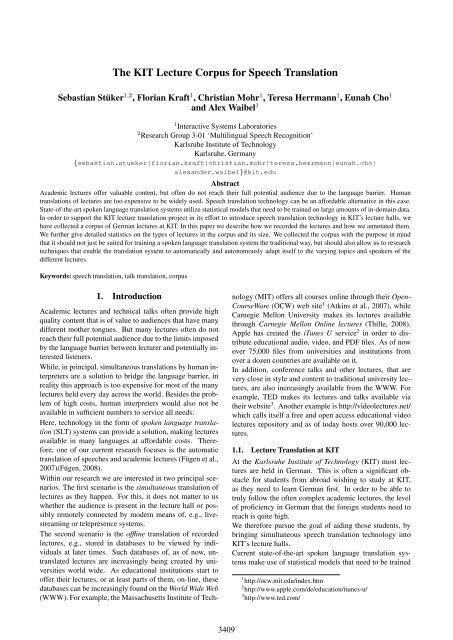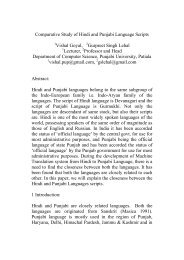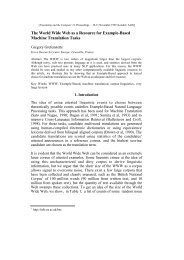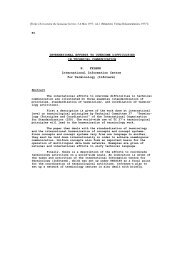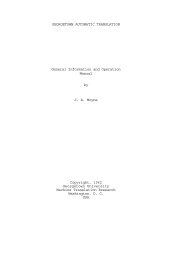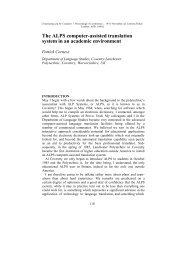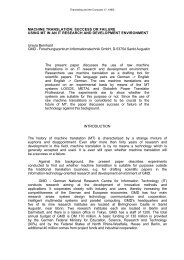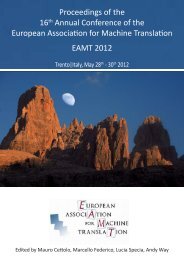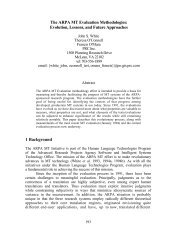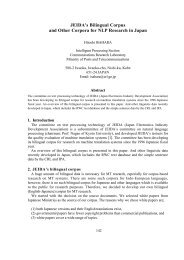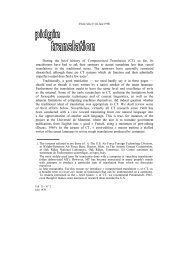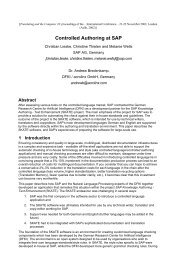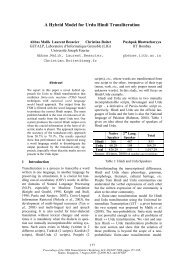The KIT lecture corpus for speech translation - Machine Translation ...
The KIT lecture corpus for speech translation - Machine Translation ...
The KIT lecture corpus for speech translation - Machine Translation ...
Create successful ePaper yourself
Turn your PDF publications into a flip-book with our unique Google optimized e-Paper software.
<strong>The</strong> <strong>KIT</strong> Lecture Corpus <strong>for</strong> Speech <strong>Translation</strong><br />
Sebastian Stüker 1,2 , Florian Kraft 1 , Christian Mohr 1 , Teresa Herrmann 1 , Eunah Cho 1<br />
and Alex Waibel 1<br />
1 Interactive Systems Laboratories<br />
2 Research Group 3-01 ‘Multilingual Speech Recognition’<br />
Karlsruhe Institute of Technology<br />
Karlsruhe, Germany<br />
{sebastian.stueker|florian.kraft|christian.mohr|teresa.herrmann|eunah.cho|<br />
alexander.waibel}@kit.edu<br />
Abstract<br />
Academic <strong>lecture</strong>s offer valuable content, but often do not reach their full potential audience due to the language barrier. Human<br />
<strong>translation</strong>s of <strong>lecture</strong>s are too expensive to be widely used. Speech <strong>translation</strong> technology can be an af<strong>for</strong>dable alternative in this case.<br />
State-of-the-art spoken language <strong>translation</strong> systems utilize statistical models that need to be trained on large amounts of in-domain data.<br />
In order to support the <strong>KIT</strong> <strong>lecture</strong> <strong>translation</strong> project in its ef<strong>for</strong>t to introduce <strong>speech</strong> <strong>translation</strong> technology in <strong>KIT</strong>’s <strong>lecture</strong> halls, we<br />
have collected a <strong>corpus</strong> of German <strong>lecture</strong>s at <strong>KIT</strong>. In this paper we describe how we recorded the <strong>lecture</strong>s and how we annotated them.<br />
We further give detailed statistics on the types of <strong>lecture</strong>s in the <strong>corpus</strong> and its size. We collected the <strong>corpus</strong> with the purpose in mind<br />
that it should not just be suited <strong>for</strong> training a spoken language <strong>translation</strong> system the traditional way, but should also allow us to research<br />
techniques that enable the <strong>translation</strong> system to automatically and autonomously adapt itself to the varying topics and speakers of the<br />
different <strong>lecture</strong>s.<br />
Keywords: <strong>speech</strong> <strong>translation</strong>, talk <strong>translation</strong>, <strong>corpus</strong><br />
1. Introduction<br />
Academic <strong>lecture</strong>s and technical talks often provide high<br />
quality content that is of value to audiences that have many<br />
different mother tongues. But many <strong>lecture</strong>s often do not<br />
reach their full potential audience due to the limits imposed<br />
by the language barrier between <strong>lecture</strong>r and potentially interested<br />
listeners.<br />
While, in principal, simultaneous <strong>translation</strong>s by human interpreters<br />
are a solution to bridge the language barrier, in<br />
reality this approach is too expensive <strong>for</strong> most of the many<br />
<strong>lecture</strong>s held every day across the world. Besides the problem<br />
of high costs, human interpreters would also not be<br />
available in sufficient numbers to service all needs.<br />
Here, technology in the <strong>for</strong>m of spoken language <strong>translation</strong><br />
(SLT) systems can provide a solution, making <strong>lecture</strong>s<br />
available in many languages at af<strong>for</strong>dable costs. <strong>The</strong>re<strong>for</strong>e,<br />
one of our current research focuses is the automatic<br />
<strong>translation</strong> of <strong>speech</strong>es and academic <strong>lecture</strong>s (Fügen et al.,<br />
2007)(Fügen, 2008).<br />
Within our research we are interested in two principal scenarios.<br />
<strong>The</strong> first scenario is the simultaneous <strong>translation</strong> of<br />
<strong>lecture</strong>s as they happen. For this, it does not matter to us<br />
whether the audience is present in the <strong>lecture</strong> hall or possibly<br />
remotely connected by modern means of, e.g., livestreaming<br />
or telepresence systems.<br />
<strong>The</strong> second scenario is the offline <strong>translation</strong> of recorded<br />
<strong>lecture</strong>s, e.g., stored in databases to be viewed by individuals<br />
at later times. Such databases of, as of now, untranslated<br />
<strong>lecture</strong>s are increasingly being created by universities<br />
world wide. As educational institutions start to<br />
offer their <strong>lecture</strong>s, or at least parts of them, on-line, these<br />
databases can be increasingly found on the World Wide Web<br />
(WWW). For example, the Massachusetts Institute of Tech-<br />
3409<br />
nology (MIT) offers all courses online through their Open-<br />
CourseWare (OCW) web site 1 (Atkins et al., 2007), while<br />
Carnegie Mellon University makes its <strong>lecture</strong>s available<br />
through Carnegie Mellon Online <strong>lecture</strong>s (Thille, 2008).<br />
Apple has created the iTunes U service 2 in order to distribute<br />
educational audio, video, and PDF files. As of now<br />
over 75,000 files from universities and institutions from<br />
over a dozen countries are available on it.<br />
In addition, conference talks and other <strong>lecture</strong>s, that are<br />
very close in style and content to traditional university <strong>lecture</strong>s,<br />
are also increasingly available from the WWW. For<br />
example, TED makes its <strong>lecture</strong>s and talks available via<br />
their website 3 . Another example is http://video<strong>lecture</strong>s.net/<br />
which calls itself a free and open access educational video<br />
<strong>lecture</strong>s repository and as of today hosts over 90,000 <strong>lecture</strong>s.<br />
1.1. Lecture <strong>Translation</strong> at <strong>KIT</strong><br />
At the Karlsruhe Institute of Technology (<strong>KIT</strong>) most <strong>lecture</strong>s<br />
are held in German. This is often a significant obstacle<br />
<strong>for</strong> students from abroad wishing to study at <strong>KIT</strong>,<br />
as they need to learn German first. In order to be able to<br />
truly follow the often complex academic <strong>lecture</strong>s, the level<br />
of proficiency in German that the <strong>for</strong>eign students need to<br />
reach is quite high.<br />
We there<strong>for</strong>e pursue the goal of aiding those students, by<br />
bringing simultaneous <strong>speech</strong> <strong>translation</strong> technology into<br />
<strong>KIT</strong>’s <strong>lecture</strong> halls.<br />
Current state-of-the-art spoken language <strong>translation</strong> systems<br />
make use of statistical models that need to be trained<br />
1 http://ocw.mit.edu/index.htm<br />
2 http://www.apple.com/de/education/itunes-u/<br />
3 http://www.ted.com/
on large amounts of in-domain training data (Federico et<br />
al., 2011) (Lamel et al., 2011) (Boudahmane et al., 2011).<br />
<strong>The</strong>re<strong>for</strong>e, in order to tailor our simultaneous <strong>speech</strong> <strong>translation</strong><br />
system to <strong>KIT</strong> wide <strong>lecture</strong>s, we started a comprehensive<br />
data collection ef<strong>for</strong>t <strong>for</strong> <strong>lecture</strong>s at <strong>KIT</strong>.<br />
2. Data Needs of Spoken Language<br />
<strong>Translation</strong> Systems <strong>for</strong> Lectures<br />
Academic <strong>lecture</strong>s and conference talks have only recently<br />
become the interest of research projects and evaluations,<br />
such as the IWSLT evaluation campaign (Paul et al., 2010)<br />
(Federico et al., 2011) or the <strong>lecture</strong> <strong>translation</strong> project at<br />
<strong>KIT</strong>. As discussed above, here, SLT systems can service a<br />
need that cannot be fulfilled by human translators. While<br />
the quality of SLT systems still lacks that of human translators,<br />
their per<strong>for</strong>mance has increased over the years, and<br />
they start to be of value to users now (Hamon et al., 2007).<br />
In order to develop SLT systems that per<strong>for</strong>m well <strong>for</strong> the<br />
task of translating German <strong>KIT</strong> <strong>lecture</strong>s, new data resources<br />
are needed that are not available so far.<br />
While the concentration on <strong>lecture</strong>s already limits the domain<br />
of the SLT system somewhat, the topics encountered<br />
in the <strong>lecture</strong>s can still be arbitrary and thus, the domain<br />
of <strong>lecture</strong>s can still be seen as practically unlimited. Data<br />
resources made available <strong>for</strong> the <strong>speech</strong> <strong>translation</strong> systems<br />
there<strong>for</strong>e need to capture this diversity in order to be able<br />
to train appropriate models, and, even more important, to<br />
reliably assess the quality of the systems developed.<br />
As <strong>for</strong> all learning systems that use statistical models,<br />
<strong>speech</strong> <strong>translation</strong> systems need two separate sets of resources:<br />
one <strong>for</strong> training and one <strong>for</strong> evaluating the system<br />
and monitoring its progress.<br />
For training and testing the automatic <strong>speech</strong> recognition<br />
(ASR) component of the SLT system large amounts of indomain<br />
audio data are needed that are transcribed at word<br />
level. For the machine <strong>translation</strong> (MT) component of the<br />
system, data is needed that consists of parallel sentences<br />
in the required domain in all languages between which the<br />
system is supposed to translate.<br />
Since <strong>lecture</strong>s provide such a diverse set of topics, we<br />
anticipate that—especially with respect to the language<br />
model, <strong>translation</strong> model, and vocabulary—the traditional<br />
approach of training systems on a fixed set of data and then<br />
deploying them, will not be sufficient. We assume that reasonable<br />
per<strong>for</strong>mance will only be reached by systems that<br />
are able to flexibly and autonomously adapt themselves to<br />
varying topics of <strong>lecture</strong>s. In order to facilitate this adaptation<br />
process, the presence of verbose meta-data, such as the<br />
name of the <strong>lecture</strong>r, his field of expertise, the title of the<br />
<strong>lecture</strong>, or the slides used by him, is very valuable.<br />
<strong>The</strong> <strong>corpus</strong> collected by us reflects those needs, and is thus<br />
not only intended as a resource <strong>for</strong> training SLT systems the<br />
traditional way, but also as a tool <strong>for</strong> conducting research<br />
to advance the state-of-the-art in autonomous and unsupervised<br />
adaptation <strong>for</strong> SLT systems.<br />
3. Corpus Collection<br />
We started the collection of our German <strong>lecture</strong> <strong>corpus</strong> with<br />
two main goals in mind. First, we wanted to obtain the necessary<br />
resources to train a <strong>speech</strong> <strong>translation</strong> system on the<br />
3410<br />
German <strong>lecture</strong> domain the traditional way, by annotating<br />
sufficient amounts of in-domain data. But since this traditional<br />
approach is not suited <strong>for</strong> deploying <strong>lecture</strong> <strong>translation</strong><br />
systems <strong>for</strong> all <strong>lecture</strong>s at <strong>KIT</strong>, we wanted to collect<br />
a database that could be used <strong>for</strong> developing the necessary<br />
technology to be able to let the <strong>translation</strong> system adapt itself<br />
automatically to new <strong>lecture</strong>rs and topics.<br />
We there<strong>for</strong>e sought to collect a wide variety of <strong>lecture</strong>s<br />
from as many different faculties, <strong>lecture</strong>rs, and topics as<br />
possible. By collecting not only single <strong>lecture</strong>s, but where<br />
possible, a series of <strong>lecture</strong>s from the same class, we sought<br />
to get the necessary base to per<strong>for</strong>m experiments that simulate<br />
the development of the <strong>lecture</strong> <strong>translation</strong> system over<br />
time when applied in real-life.<br />
3.1. Data Collection and Annotation<br />
Our data collection was per<strong>for</strong>med within the <strong>lecture</strong> halls<br />
at <strong>KIT</strong>. <strong>The</strong> diversity of the collected <strong>lecture</strong>s evolved over<br />
time. While in the beginning we collected <strong>lecture</strong>s given<br />
by people from our laboratory, we later expanded the collection<br />
to <strong>lecture</strong>s from the computer science faculty in general,<br />
and then, later on, to <strong>lecture</strong>s from all faculties of <strong>KIT</strong>.<br />
In addition to just collecting the audio from the speaker, we<br />
also collected, where possible, the slides used in the <strong>lecture</strong>,<br />
including timing in<strong>for</strong>mation of slide changes, and made a<br />
video recording of the <strong>lecture</strong>. <strong>The</strong> <strong>lecture</strong>r’s audio was<br />
then manually transcribed and translated in order to create<br />
the necessary <strong>corpus</strong>.<br />
3.1.1. Recording<br />
<strong>The</strong> recordings of the <strong>lecture</strong>s were conducted by student<br />
part timers that were trained on the recording equipment by<br />
staff from our laboratory. Figure 1 gives an overview of the<br />
recording process.<br />
<strong>The</strong> <strong>lecture</strong>r’s <strong>speech</strong> was picked-up with three different<br />
microphones: a) a close-talking microphone (Countryman<br />
E6 Earset), b) a lavalier microphone (Sennheiser ME4N),<br />
and c) a dynamic hand held microphone that is worn around<br />
the neck with a string. <strong>The</strong> last type of microphone is the<br />
one normally used in <strong>KIT</strong>’s <strong>lecture</strong> halls to broad cast the<br />
<strong>lecture</strong>r’s <strong>speech</strong> over the <strong>lecture</strong> hall’s PA system. Depending<br />
on the <strong>lecture</strong> hall and <strong>lecture</strong> recorded the last<br />
type of microphone was not available in all cases. All microphones<br />
are wireless microphones as not to inhibit the<br />
movement of the <strong>lecture</strong>rs. While the close-talking microphone<br />
and the lavalier microphone are connected to a<br />
wireless transmitter, the dynamic hand held microphone<br />
has an inbuilt transmitter. <strong>The</strong> recording student set up the<br />
transmission frequency of wireless senders and receivers<br />
(Sennheiser EW 100 G3) so as not to interfere with other<br />
wireless transmissions in the environment. <strong>The</strong> receivers<br />
of the three wireless microphones were connected to multi<br />
channel sound cards (Cakewalk UA-25EX). One channel<br />
(usually from the lavalier microphone) was <strong>for</strong>warded to<br />
the audio-input of the camcorder (Canon Legria HFS20E),<br />
in order not to capture the environmental noise of the <strong>lecture</strong><br />
hall in the video recording. <strong>The</strong> multi channel sound<br />
cards were connected via USB to a recording laptop, where<br />
each channel was stored at 48 kHz with 24 bit resolution.<br />
<strong>The</strong> recording student adjusted and monitored the gain level
Figure 1: Overview of the <strong>lecture</strong> recording process, using three wireless microphones, recording of the slides’ video with<br />
timestamps, as well as video recording of the presentation<br />
and audio quality of all devices and channels in the transmission<br />
chain using headphones and visual feedback during<br />
the whole <strong>lecture</strong>.<br />
In addition to the audio and video from the <strong>lecture</strong>r we also<br />
collected his slides. In the beginning we simply copied the<br />
slides from the <strong>lecture</strong>. Later on we used a tool on the<br />
presenters laptop that captures the slides and the transition<br />
times <strong>for</strong> PowerPoint slides. When it was not possible to install<br />
the tool on the <strong>lecture</strong>r’s laptop, the recording assistant<br />
logged the slide changes manually using the same software<br />
on his laptop. Since the presentation <strong>for</strong>mat of different <strong>lecture</strong>rs<br />
or even in one and the same <strong>lecture</strong> might vary, and<br />
we wanted to become independent of the specific presentation<br />
software used, we started capturing the video signal<br />
send from the presentation laptop to the video projector using<br />
an external video grabber (Epiphan DVI2USB). Slide<br />
transition times as well as text content from the slides can<br />
now be extracted offline in an automatic way using OCR.<br />
After each <strong>lecture</strong> the audio recordings were post-processed<br />
by the recording assistants. <strong>The</strong>ir amplitude was normalized<br />
and they were down sampled to 16 kHz with 16 bit resolution,<br />
which is the standard input <strong>for</strong>mat <strong>for</strong> our <strong>speech</strong><br />
recognition front-end.<br />
All captured and processed in<strong>for</strong>mation including the various<br />
acoustic and video channels, the time stamps and metain<strong>for</strong>mation<br />
about the <strong>lecture</strong>r, the <strong>lecture</strong> time and place<br />
and the recording protocol are stored and documented in a<br />
3411<br />
predefined structure.<br />
3.1.2. Transcription<br />
As soon as newly processed <strong>lecture</strong> recordings were available,<br />
the recording channel with best audio quality was<br />
added to the transcription chain. <strong>The</strong> real-time factor<br />
<strong>for</strong> creating a one-pass transcription is between 15x and<br />
30x depending on the experience and carefulness of the<br />
transcriber. <strong>The</strong>re is actually not too much variability in<br />
the acoustic events across different channels of the same<br />
recording, so the transcription can be applied to all microphone<br />
channels which are time synchronous. <strong>The</strong> transcriptions<br />
of the <strong>lecture</strong> recordings were conducted by student<br />
part timers that were trained by a linguist or by an experienced<br />
transcription student. <strong>The</strong> transcription guidelines<br />
were derived from the transliteration guideline <strong>for</strong> spontaneous<br />
<strong>speech</strong> data developed within Verbmobil II (Burger,<br />
1997). <strong>The</strong> following changes were applied:<br />
• German umlauts were directly written down.<br />
• Comments to pronunciation, e.g., slang, were marked<br />
with a percent sign appended to the original <strong>for</strong>m<br />
(haben%) instead of using arrow brackets<br />
• Spellings and acronyms were written without the dollar<br />
signs as marker.<br />
• <strong>The</strong> tilde sign was omitted as a marker <strong>for</strong> named entities.
• <strong>The</strong> hash sign was omitted as a marker <strong>for</strong> numbers.<br />
• Numbers were written without a slash and separated<br />
in 10th groups (i.e. ”vierundfünfzig”, but ”ein hundert<br />
vierundfünfzig”)<br />
• Overlapping <strong>speech</strong>, background <strong>speech</strong>, and background<br />
noises are not annotated.<br />
<strong>The</strong> transcription is per<strong>for</strong>med in three stages. In the first<br />
stage a transcriber segments and transcribes the recording.<br />
In the second pass a different transcriber improves the transcripts<br />
of the first pass. In the third pass the output of the<br />
second pass is spell and sanity checked to account <strong>for</strong> new<br />
German spelling rules as well as typing errors.<br />
3.1.3. <strong>Translation</strong><br />
After transcription the German <strong>lecture</strong>s are translated into<br />
English and French. <strong>The</strong> <strong>translation</strong>s are per<strong>for</strong>med by student<br />
research assistants who study at the School of <strong>Translation</strong>,<br />
Interpreting, Linguistics and Cultural Studies of the<br />
University of Mainz in Germersheim, Germany. As translators<br />
in training they produce high-quality <strong>translation</strong>s <strong>for</strong><br />
the <strong>lecture</strong> transcriptions which present a challenging task<br />
containing on the one hand very specialized technical terms<br />
and on the other hand spontaneous and colloquial <strong>speech</strong>.<br />
We make sure that either the source or target language is the<br />
translator’s mother tongue. All translators work part-time<br />
and on an hourly basis as their study programme allows.<br />
4. Corpus Details and Transcriptions<br />
Our collection ef<strong>for</strong>ts already started in 2006, but have<br />
picked up pace over the last two years. While recording<br />
and annotation is still on-going we will give in the following<br />
paragraphs an overview of the current status of the size<br />
and properties of the <strong>corpus</strong> as of spring 2012.<br />
Table 1 gives an overview of the types and amounts of <strong>lecture</strong>s<br />
recorded. One can see that the bulk of the <strong>lecture</strong>s<br />
comes from computer science. This is due to the fact that<br />
in the beginning we exclusively collected computer science<br />
<strong>lecture</strong>s and only two years ago started to also collect <strong>lecture</strong>s<br />
from other departments. In addition to real university<br />
<strong>lecture</strong>s, we also occasionally collected <strong>speech</strong>es and addresses<br />
given by university representatives, e.g., the president<br />
of the university or the dean of a specific faculty, at<br />
festive or public events.<br />
As transcription is a time-intensive process, one can see that<br />
the majority of the recorded data is not transcribed yet. But<br />
at least within computer science, the amount of ca. 46h of<br />
completely transcribed and 29h of at least first pass transcribed<br />
<strong>lecture</strong>s is already significant and suited <strong>for</strong> traditional<br />
system development.<br />
<strong>The</strong> amount of translated material is naturally lacking behind<br />
the amount of transcribed material, as it has to wait <strong>for</strong><br />
the transcriptions first. <strong>The</strong> amount of material translated to<br />
French is particularly small, as we were only able to recruit<br />
one translator <strong>for</strong> French so far.<br />
Table 2 gives some more statistics on the <strong>lecture</strong>s. <strong>The</strong><br />
recorded <strong>lecture</strong>s contain a total of 44 speakers, the majority<br />
of them, 36, being male speakers. Most <strong>lecture</strong>s, 38,<br />
are from the computer science department, though these<br />
3412<br />
<strong>lecture</strong>s also contain <strong>lecture</strong>s from the so-called Center of<br />
Applied Law which teaches law with a focus on aspects related<br />
to in<strong>for</strong>mation technology, and is thus officially part<br />
of the computer science department. From non-computer<br />
science departments mostly only one <strong>lecture</strong> each has been<br />
recorded so far.<br />
In case we were able to record at least five <strong>lecture</strong>s of a<br />
class, we call this a series of <strong>lecture</strong>s, otherwise we talk<br />
of single <strong>lecture</strong>s. Most of the recordings of the <strong>lecture</strong>s<br />
are single <strong>lecture</strong>s instead of a series of <strong>lecture</strong>s from the<br />
same class. This is often due to the fact, that many <strong>lecture</strong>rs<br />
agreed to have one or two <strong>lecture</strong>s recorded, but thought the<br />
recording process to be too intrusive as to have the complete<br />
class recorded.<br />
Table 1: Duration of the recorded <strong>lecture</strong>s and word count<br />
statistics on the transcriptions and <strong>translation</strong>s<br />
Type of talk recorded (hh:mm:ss) # words<br />
Computer Science (CS)<br />
Total 185:21:09 -<br />
2nd pass transcribed 45:47:09 438,922<br />
1st pass transcribed 29:03:50 273,281<br />
not transcribed 110:30:10 -<br />
English <strong>translation</strong> 29:39:26 290,610<br />
French <strong>translation</strong> 2:00:36 20,878<br />
Non Computer Science<br />
(Non-CS)<br />
Total 7:52:16 88,214<br />
2nd pass transcribed 5:35:53 55,575<br />
1st pass transcribed 2:16:23 32,639<br />
English <strong>translation</strong> 3:47:25 43,301<br />
French <strong>translation</strong> 0:05:47 777<br />
Miscellaneous Talks<br />
(Misc)<br />
Total 4:13:13 -<br />
2nd pass transcribed 3:38:06 30,328<br />
not transcribed 0:35:07 -<br />
English <strong>translation</strong> 3:38:06 30,328<br />
5. Initial Experiments<br />
In order to give an impression of how difficult the collected<br />
<strong>lecture</strong>s are <strong>for</strong> the task of spoken language <strong>translation</strong>, we<br />
per<strong>for</strong>med some initial recognition and <strong>translation</strong> experiments<br />
on selected <strong>lecture</strong>s from our <strong>corpus</strong>. For these experiments<br />
we used a legacy <strong>speech</strong> recognition and a legacy<br />
<strong>translation</strong> system and concatenated them.<br />
5.1. Test Data Selection<br />
From the available <strong>lecture</strong>s we selected two of the miscellaneous<br />
talks and three of the computer science <strong>lecture</strong>s. One<br />
of the CS <strong>lecture</strong>s and one of the Misc talks were given<br />
by the same speaker. <strong>The</strong> <strong>lecture</strong>s were chosen, because<br />
transcriptions and <strong>translation</strong>s were available <strong>for</strong> them, and<br />
because they were not included in the training data of the<br />
machine <strong>translation</strong> system used, which has already been<br />
trained, at least in part, on the newly collected data.
Table 2: Statistics on speakers and <strong>lecture</strong> types<br />
General<br />
Number of speakers 44<br />
Female speakers 8<br />
Male speakers<br />
Departments<br />
36<br />
Computer Science 38<br />
Mechanical Engineering 2<br />
Electrical Engineering 1<br />
Civil Engineering, Geological and Environmental 1<br />
Science<br />
Humanities and Social Science 1<br />
Lecture series recorded 9<br />
Single <strong>lecture</strong>s recorded 31<br />
Miscellaneous talks recorded 9<br />
Table 3: Initial Experiments—ASR Results: word error<br />
rates (WER) in %, language model perplexity (LM PPL),<br />
and out-of-vocabulary rates (OOV) in %<br />
Lecture WER LM PPL OOV<br />
Misc 1 spk 1 20.7 289.4 1.2<br />
Misc 2 spk 2 26.6 214.2 0.8<br />
CS spk 1 29.8 311.6 1.0<br />
CS spk 3 43.4 305.7 1.4<br />
CS spk 4 36.4 291.1 1.3<br />
5.2. ASR Results<br />
For per<strong>for</strong>ming our ASR experiments we used our German<br />
<strong>speech</strong>-to-text system with which we participated in<br />
the 2011 Quaero evaluation (Lamel et al., 2011). This system<br />
is a further development of our 2010 evaluation system<br />
(Stüker et al., 2012). <strong>The</strong> domain targeted within the<br />
Quaero evaluation is that of broadcast news, broadcast conversation<br />
and podcasts downloaded from the Web. <strong>The</strong>re<strong>for</strong>e,<br />
there is a substantial mismatch in domain to which the<br />
Quaero ASR system has been tuned and the targeted <strong>lecture</strong><br />
domain.<br />
Table 3 shows the case-sensitive word error rates (WER) <strong>for</strong><br />
the five recordings in the test set. It further shows the perplexity<br />
(PPL) of the ASR system’s language model on the<br />
<strong>lecture</strong>s and talks, as well as the out-of-vocabulary (OOV)<br />
rates of the system’s vocabulary.<br />
One can see that recognizing the miscellaneous talks is significantly<br />
easier with the Quaero system than recognizing<br />
the computer science <strong>lecture</strong>s. This is both reflected in the<br />
lower word error rates and language model perplexity. <strong>The</strong><br />
OOV rate on all talks is considerably low, which at least in<br />
part is due to the large vocabulary (300k) which makes use<br />
of sub-word units.<br />
5.3. Speech and <strong>Machine</strong> <strong>Translation</strong> Results<br />
Two types of machine <strong>translation</strong> experiments were conducted<br />
on the <strong>lecture</strong> data. For one, the output of the automatic<br />
<strong>speech</strong> recognition system as described above was<br />
3413<br />
used as input to an SMT system. Be<strong>for</strong>e <strong>translation</strong> text<br />
normalization, compound splitting and smart-casing was<br />
applied to the ASR output. A second set of experiments,<br />
where we translated the reference transcriptions of the <strong>lecture</strong>s<br />
shows the upper bound of <strong>translation</strong> quality. For<br />
<strong>translation</strong> we used a state-of-the-art phrase-based SMT<br />
system especially developed <strong>for</strong> the <strong>translation</strong> of <strong>lecture</strong><br />
data. <strong>Translation</strong> and language models were adapted using<br />
a large amount of in-domain <strong>lecture</strong> data, which we<br />
gathered from <strong>lecture</strong>s given at <strong>KIT</strong>. We also utilized TED 4<br />
data as an additional in-domain training data, <strong>for</strong> a better<br />
adaptation towards <strong>speech</strong> <strong>translation</strong>. To cover long-range<br />
reorderings between the source and target language, partof-<strong>speech</strong>-based<br />
reordering was applied. Table 4 presents<br />
the results of the end-to-end evaluation (ASR) and the oracle<br />
evaluation (Transcript) of this first automatic <strong>speech</strong><br />
<strong>translation</strong> experiment. <strong>The</strong> <strong>translation</strong> quality was measured<br />
ignoring punctuation and is presented using the caseinsensitive<br />
BLEU score (Papineni et al., 2002).<br />
Table 4: Initial Experiments—MT Results: BLEU score on<br />
ASR input and reference transcriptions<br />
Lecture ASR Transcripts<br />
Misc 1 spk 1 25.30 33.53<br />
Misc 2 spk 2 24.36 34.90<br />
CS spk 1 21.02 30.19<br />
CS spk 3 13.35 26.57<br />
CS spk 4 18.48 33.01<br />
6. Conclusion<br />
In this paper we presented our ef<strong>for</strong>ts in collecting a <strong>corpus</strong><br />
<strong>for</strong> supporting our research within the frame work of the<br />
<strong>KIT</strong> <strong>lecture</strong> <strong>translation</strong> project. <strong>The</strong> goal of the project is<br />
to bring spoken language <strong>translation</strong> technology into <strong>KIT</strong>’s<br />
<strong>lecture</strong> hall, in order to make it easier <strong>for</strong> <strong>for</strong>eign students,<br />
that are not sufficiently fluent in German, to attend <strong>lecture</strong>s<br />
at <strong>KIT</strong>. While originally seeded in the computer science<br />
department, our <strong>corpus</strong> is intended to be diverse enough,<br />
in order to reflect the wide diversity of topics and speaker<br />
encountered in <strong>lecture</strong>s at <strong>KIT</strong>. <strong>The</strong> <strong>corpus</strong> is not only intended<br />
to enable us to train spoken language <strong>translation</strong> systems<br />
in the traditional way, but rather to support research in<br />
advancing techniques that will allow the <strong>translation</strong> system<br />
to automatically and autonomously adapt itself to the varying<br />
topics and speakers.<br />
7. Acknowledgements<br />
‘Research Group 3-01’ received financial support by the<br />
‘Concept <strong>for</strong> the Future’ of Karlsruhe Institute of Technology<br />
within the framework of the German Excellence Initiative.<br />
8. References<br />
Daniel E. Atkins, John Seely Brown, and Allen L. Hammond.<br />
2007. A review of the open educational resources<br />
4 http://www.ted.com
(oer) movement: Achievements, challenges, and new<br />
opportunities. Technical report, <strong>The</strong> William and Flora<br />
Hewlett Foundation, February.<br />
Karim Boudahmane, Bianka Buschbeck, Eunah Cho,<br />
Joseph Maria Crego, Markus Freitag, Thomas Lavergne,<br />
Herrmann Ney, Jan Niehues, Stephan Peitz, Jean Senellart,<br />
Artem Sokolov, Alex Waibel, Tonio Wandmacher,<br />
Jörn Wübker, and François Yvon. 2011. Speech recognition<br />
<strong>for</strong> machine <strong>translation</strong> in quaero. In International<br />
Workshop on Spoken Language <strong>Translation</strong> (IWSLT),<br />
San Francisco, CA.<br />
Susanne Burger. 1997. Transliteration spontanprachlicher<br />
Daten - Lexikon der Transliterationskonventionen<br />
- Verbmobil 2. http://www.phonetik.unimuenchen.de/Forschung/Verbmobil/VMtrlex2d.html.<br />
Marcello Federico, Luisa Bentivogli, Michael Paul, and<br />
Sebastian Stüker. 2011. Overview of the IWSLT 2011<br />
Evaluation Campaign. In International Workshop on<br />
Spoken Language <strong>Translation</strong> (IWSLT), San Francisco,<br />
CA.<br />
Christian Fügen, Alex Waibel, and Muntsin Kolss. 2007.<br />
Simultaneous <strong>translation</strong> of <strong>lecture</strong>s and <strong>speech</strong>es. <strong>Machine</strong><br />
<strong>Translation</strong>, 21:209–252.<br />
Christian Fügen. 2008. A System <strong>for</strong> Simultaneous <strong>Translation</strong><br />
of Lectures and Speeches. Ph.D. thesis, Universiät<br />
Karlsruhe (TH), November.<br />
O. Hamon, D. Mostefa, and K. Choukri. 2007. End-to-end<br />
evaluation of a <strong>speech</strong>-to-<strong>speech</strong> <strong>translation</strong> system in<br />
TC-STAR. In Proc. of <strong>Machine</strong> <strong>Translation</strong> Summit XI,<br />
pages 223–230, Copenhagen, Denmark, 10-14. September.<br />
Lori Lamel, Sandrine Courcinous, Julien Despres, Jean-<br />
Luc Gauvain, Yvan Josse, Kevin Kilgour, Florian Kraft,<br />
Le Viet Bac, Hermann Ney, Markus Nubaum-Thom,<br />
Ilya Oparin, Tim Schlippe, Ralf Schlter, Tanja Schultz,<br />
Thiago Fraga Da Silva, Sebastian Stüker, Martin Sundermeyer,<br />
Bianca Vieru, Ngoc Thang Vu, Alexander<br />
Waibel, and Ccile Woehrling. 2011. Speech recognition<br />
<strong>for</strong> machine <strong>translation</strong> in quaero. In International<br />
Workshop on Spoken Language <strong>Translation</strong> (IWSLT),<br />
San Francisco, CA.<br />
Kishore Papineni, Salim Roukos, Todd Ward, and Wei-<br />
Jing Zhu. 2002. Bleu: a Method <strong>for</strong> Automatic Evaluation<br />
of <strong>Machine</strong> <strong>Translation</strong>. Technical Report RC22176<br />
(W0109-022), IBM Research Division, T. J. Watson Research<br />
Center.<br />
Michael Paul, Marcello Federico, and Sebastian Stüker.<br />
2010. Overview of the iwslt 2010 evaluation campaign.<br />
In Proc. of the International Workshop on Spoken Language<br />
<strong>Translation</strong> (IWSLT), Paris, France, 2–3. December.<br />
Sebastian Stüker, Kevin Kilgour, and Florian Kraft. 2012.<br />
Quaero <strong>speech</strong>-to-text evaluation systems. In High Per<strong>for</strong>mance<br />
Computing in Science and Engineering ’11,<br />
pages 607–618. Springer Berlin Heidelberg.<br />
Candace Thille. 2008. Building open learning as a<br />
community-based research activity. In Toru Iiyoshi and<br />
M.S. Vijay Kumar, editors, Opening Up Education—<br />
<strong>The</strong> Collective Advancement of Education through Open<br />
3414<br />
Technology, Open Content, and Open Knowledge. <strong>The</strong><br />
Carnegie Foundation <strong>for</strong> the Advancement of Teaching,<br />
<strong>The</strong> MIT Press, Cambridge Massachusetts, USA and<br />
London, England.


